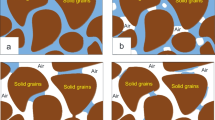Abstract
The stability of a cavity underlying homogeneous clay in an unsupported greenfield condition is examined in this paper using the finite difference program, FLAC. Shear strength reduction method (SSRM) is utilised to study two- and three-dimensional failure mechanisms of a horizontal trapdoor. Stability results are presented in the forms of factors of safety (FoS) and failure extent ratios for various dimensionless ratios. Numerical results are compared with the finite element limit analysis technique with upper and lower bound theorems, and a good agreement is found between the solutions. Several practical examples are provided to demonstrate the use of design charts and tables.












Similar content being viewed by others
References
Abbasi B, Russell D, Taghavi R (2013) 'FLAC 3D mesh and zone quality. Itasca Consulting Group, Minneapolis, Minnesota, USA
Abdulla WA, Goodings DJ (1996) Modeling of sinkholes in weakly cemented sand. J Geotech Eng 122(12):998–1005
Atkinson J, Potts D (1977) Stability of a shallow circular tunnel in cohesionless soil. Geotechnique 27(2):203–215
Augarde CE, Lyamin AV, Sloan SW (2003) Prediction of undrained sinkhole collapse. J Geotech Geoenviron Eng 129(3):197–205
Broms BB, Bennermark H (1967) ‘Stability of clay at vertical openings’, Journal of the Soil Mechanic & Foundations Division. Proc Am Soc Civ Eng 93:71–93
Craig W (1990) Collapse of cohesive overburden following removal of support. Can Geotech J 27(3):355–364
Davis E, Gunn M, Mair R, Seneviratine H (1980) The stability of shallow tunnels and underground openings in cohesive material. Geotechnique 30(4):397–416
Drumm EC, Aktürk Ö, Akgün H, Tutluoğlu L (2009) Stability charts for the collapse of residual soil in karst. J Geotech Geoenviron Eng 135(7):925–931
Itasca (2002) Fast Lagrangian analysis of continua, FLAC3D Version 2.0, Itasca Consulting Group, Minneapolis, Minnesota, USA
Itasca (2003) Fast Lagrangian analysis of continua, FLAC2D Version 5.0, Itasca Consulting Group, Minneapolis, Minnesota, USA
Jacobsz SW (2016) Trapdoor experiments studying cavity propagation. In: Proceedings of the 1st Southern African geotechnical conference. CRC Press, Taylor & Francis Group, pp 159–165
Keawsawasvong S, Ukritchon B (2017) Undrained stability of an active planar trapdoor in non-homogeneous clays with a linear increase of strength with depth. Comput Geotech 81:284–293
Krabbenhoft K, Lyamin AV (2015) Strength reduction finite-element limit analysis. Géotech Lett 5(4):250–253
Leca E, Dormieux L (1990) Upper and lower bound solutions for the face stability of shallow circular tunnels in frictional material. Geotechnique 40(4):581–606
Mettler K (2015) Seffner sinkhole’, Tampa Bay Times, Florida, United States, viewed 26 June 2018. http://www.tampabay.com/news/publicsafety/report-new-hole-opens-at-site-of-2013-fatal-sinkhole-in-seffner/2241
Mühlhaus H-B (1985) Lower bound solutions for circular tunnels in two and three dimensions. Rock Mech Rock Eng 18(1):37–52
OptumG2 (2018) Optum computational engineering. https://optumce.com/
Shiau J, Pather S, Ayers R (2006) Developing physical models for geotechnical teaching and research. In: Proceedings of 6th IC physical modelling in geotechnics, pp 157–162
Shiau J, Sams M, Lamb B (2016) Introducing advanced topics in geotechnical engineering teaching–Tunnel modelling. Int J GEOMATE 10(1):1698–1705
Shiau J, Al-Asadi F (2018) Revisiting Broms and Bennermarks’ original stability number for tunnel headings. Geotech Lett 8(4):310–315
Shiau JS, Sams MS (2019) Relating volume loss and greenfieldsettlement. Tunn Undergr Space Technol 83:145–152
Shiau J, Hassan MM (2020) Undrained stability of active and passive trapdoors. Geotech Res. https://doi.org/10.1680/jgere.19.00033
Shiau J, Al-Asadi F (2020) Determination of critical tunnel heading pressures using stability factors. Comput Geotech 119:103345
Shiau J, Hassan MM (2020) Undrained stability of active and passive trapdoors. Geotech Res 7(1):40–48
Shiau J, Lee J-S, Al-Asadi F (2021) Three-dimensional stability analysis of active and passive trapdoors. Tunn Undergr Space Technol 107:103635
Shiau J, Al-Asadi F (2021) Revisiting circular tunnel stability using Broms and Bennermarks’ original stability number. Int J Geomech 21(5):06021009
Sloan S, Assadi A, Purushothaman N (1990) Undrained stability of a trapdoor. Geotechnique 40(1):45–62
Taylor DW (1937) Stability of earth slopes. J Boston Soc Civ Eng 24(3):197–247
Terzaghi K (1936) Stress distribution in dry and saturated sand above a yielding trap-door. In: Proceedings of the international conference of soil mechanic. Harvard University Press, Cambridge, vol. 1, no. 4, pp 307–311
Tharp TM (2003) Cover-collapse sinkhole formation and soil plasticity. In: Sinkholes and the engineering and environmental impacts of Karst, pp 110–23
Vaziri HH, Jalali JS, Islam R (2001) An analytical model for stability analysis of rock layers over a circular opening. Int J Solids Struct 38(21):3735–3757
Yang MZ, Drumm EC (2002) Stability evaluation for the siting of municipal landfills in karst. Eng Geol 65(2):185–195
Author information
Authors and Affiliations
Corresponding author
Rights and permissions
About this article
Cite this article
Shiau, J., Hassan, M.M. Numerical modelling of three-dimensional sinkhole stability using finite different method. Innov. Infrastruct. Solut. 6, 183 (2021). https://doi.org/10.1007/s41062-021-00559-0
Received:
Accepted:
Published:
DOI: https://doi.org/10.1007/s41062-021-00559-0




